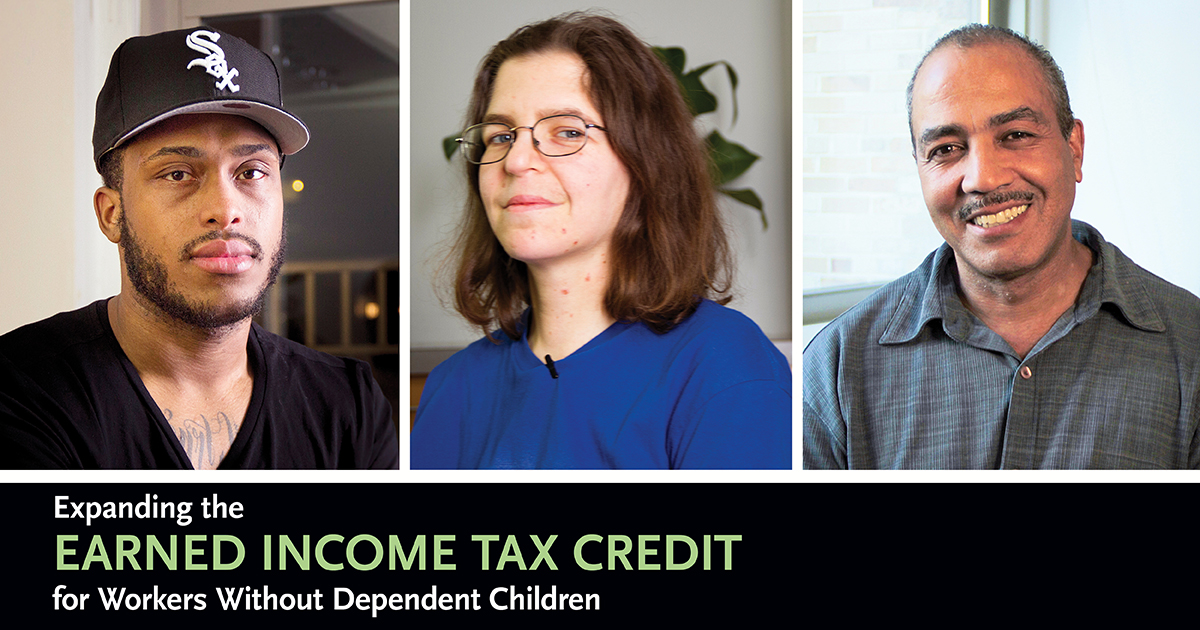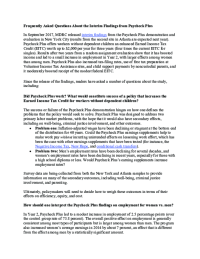Frequently Asked Questions About the Interim Findings from Paycheck Plus

In September 2017, MDRC released interim findings from the Paycheck Plus demonstration and evaluation in New York City (results from the second site in Atlanta are expected next year). Paycheck Plus offers workers without dependent children an enhanced Earned Income Tax Credit (EITC) worth up to $2,000 per year for three years (four times the current EITC for singles). Results after two years from a random assignment evaluation show that it has boosted income and led to a small increase in employment in Year 2, with larger effects among women than among men. Paycheck Plus also increased tax-filing rates, use of free tax preparation at Volunteer Income Tax Assistance sites, and child support payments by noncustodial parents, and it moderately boosted receipt of the modest federal EITC.
Since the release of the findings, readers have asked a number of questions about the study, including:
Did Paycheck Plus work? What would constitute success of a policy that increases the Earned Income Tax Credit for workers without dependent children?
The success or failure of the Paycheck Plus demonstration hinges on how one defines the problems that the policy would seek to solve. Paycheck Plus was designed to address two primary labor market problems, with the hope that it would also have secondary effects, including on well-being, criminal justice involvement, and other outcomes.
-
Problem one: Inflation-adjusted wages have been declining or stagnant at the bottom end of the distribution for 40 years. Could the Paycheck Plus earnings supplements help to make work pay without incurring unintended effects on lessening work effort, which has been the case with other earnings supplements that have been tested (for instance, the Negative Income Tax, New Hope, and conditional cash transfers).
-
Problem two: Men’s employment rates have been declining for several decades, and women’s employment rates have been declining in recent years, especially for those with a high school diploma or less. Would Paycheck Plus’s earning supplements increase employment rates?
Survey data are being collected from both the New York and Atlanta samples to provide information on many of the secondary outcomes, including well-being, criminal justice involvement, and parenting.
Ultimately, policymakers will need to decide how to weigh these outcomes in terms of their effects on efficiency, equity, and cost.
How should one interpret the Paycheck Plus findings on employment for women vs. men?
In Year 2, Paycheck Plus led to a modest increase in employment of 2.5 percentage points (over the control group rate of 73.8 percent). The overall positive effect on employment is generally consistent among most types of participants but is larger among women than men. The program also increased women’s average earnings in 2014 by about 7 percent, an effect that is different from the effect among men by a statistically significant amount.
These findings are consistent with conventional wisdom on labor supply responses to incentives for women and men. Existing research evidence on labor supply elasticities for men finds that men don't respond robustly to modest increases in earnings. The design documents developed for Paycheck Plus used this research to predict the potential effects:
Separate calculations suggest that the expanded credit would increase income by about 7 percent, on average, for all workers with earnings less than $30,000 and by 9 percent for a more disadvantaged subset, or those without a high school diploma. This increase in the return to work should increase employment rates anywhere from 1.4 percent to 9 percent.
In fact, the Paycheck Plus bonus for study sample recipients was typically equivalent to about an 11 percent wage increase over the course of a year. Given a labor supply elasticity for men of 0.3 or lower (based on conventional estimates) and the standard errors around the impact estimates for this sample, the study’s sample size in New York alone is too small to reliably detect statistically significant impacts on employment or (especially) earnings. We find about a 0.7 percentage point (or 1 percent) increase in employment for men in 2015, but the size of the standard errors means we can't rule out a 3-4 percent (or 2-3 percentage point) increase, which is what you would expect from a 0.3 labor supply elasticity.
A reasonable conclusion so far from the Paycheck Plus findings is that we are underpowered to assess reasonable impacts on employment or earnings for men based on past estimates of labor supply elasticities for men. At the design stage, the sample size of 6,000 was deemed adequate to detect an effect as small as 2 percentage points for the full sample and as small as 3.5-4.0 percentage points for a subgroup. The effect of 4.5 percentage points found for women, consistent with past research that suggests a 0.5 labor supply elasticity, was statistically significant.
We will have a bit more power to detect effects for men alone in future years when we can combine the New York City and Atlanta study samples to increase sample size.
Are there other reasons men might have been less likely to respond to the bonus?
The smaller employment response from men might also be explained by other factors. As explained in the report, despite an extensive marketing effort in Paycheck Plus, it is not possible to convey the same level of information about an earnings supplement in a demonstration project as individuals would have received from a national program, where eligible singles would learn about it from employers, private tax preparers, and official communications from the IRS and other government agencies — as well as by word-of-mouth in the community. People can’t act on an incentive if they are not knowledgeable about it.
The Paycheck Plus sample also includes a fair number of ex-offenders and fathers who owed child support — two groups known to be more likely to work in the off-the-books economy and who might be especially cautious about participating in government programs. Thus, lack of knowledge about the salience of the incentive or lack of faith in the bonus being real or credible may have also affected engagement by men. Consistent with this possibility, men in the sample have a lower take-up rate. The survey data, to be presented in the next report, may provide further information on knowledge and salience differences by gender.
And, of course, men may have faced more challenges in the labor market than women. Ideally, one would like to have the sample size and ability to combine a more generous EITC with some upfront labor market training and job search help to see if the combination works better. Paycheck Plus did provide an employment referral “nudge” to a subsample, but that intervention was very “light touch.”






